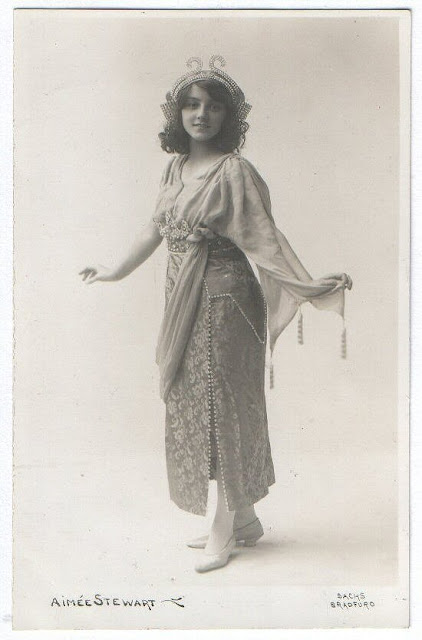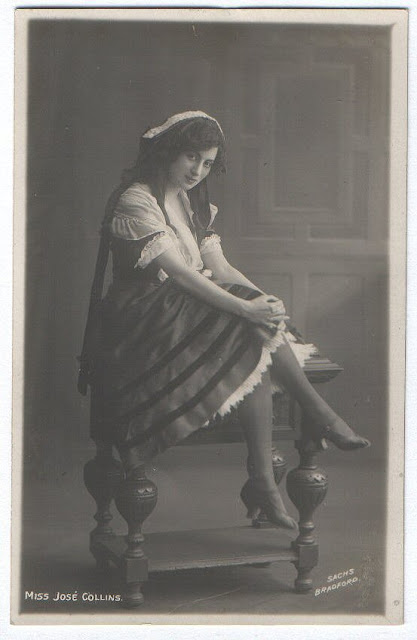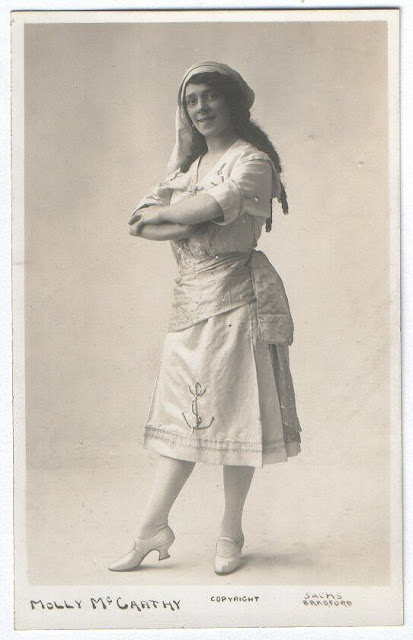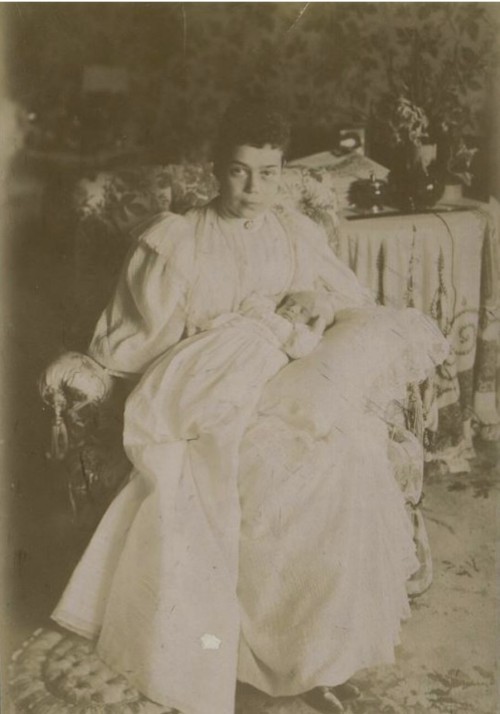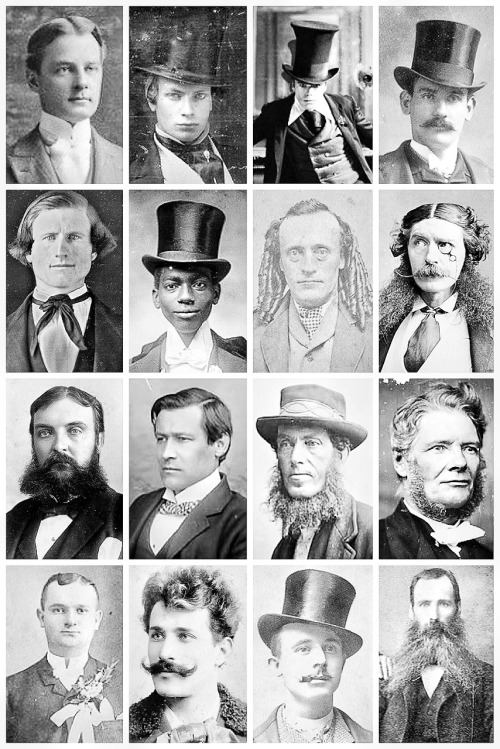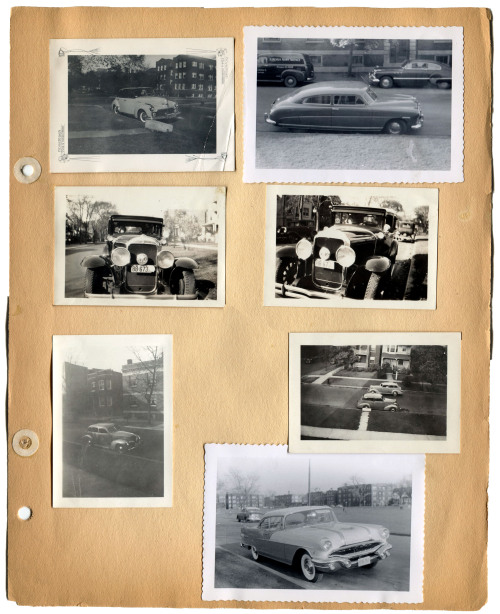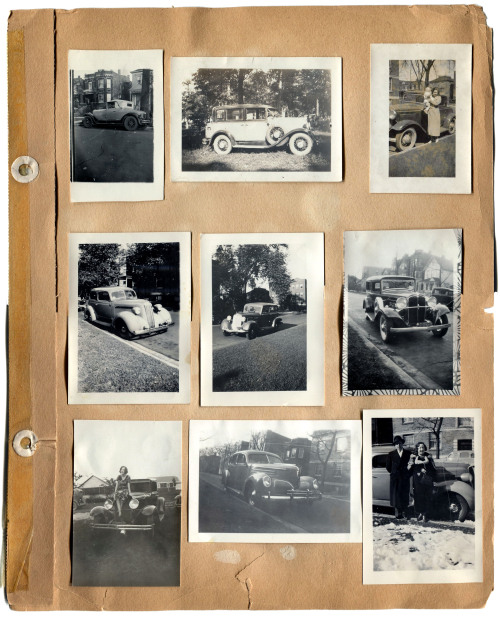#vintage photographs
Further artists’ reference photographs from 1870s France, from the studio of Louis Jean-Baptiste Igout, in addition to those shared previously. The third here is my favourite of the set, as though one describes the features of some wondrous landscape while the other surveys the scene with eager admiration!
Post link
All pictures are of Bradford music hall artistes taken between 1900 and 1920
In a 1913 anonymous ‘autobiography’ was published, claiming to be the confessions of an Victorian music hall dancing girl, born in 1887 in Camden.
Although probably entirely fictional, the memoirs make tame reading. Apart from a trip to Spain, where the dancer is besieged by love sick 16-year-old Jose, there’s not a hint of loose behaviour. The main confession of this dancing girl is that theatrical life is actually a bit dull.
When she isn’t resting between jobs the dancing girl is enduring the “ordeal” of the music hall audition circuit, which sounds rather like a sinister Edwardian version of Britain’s Got Talent:
“Have you ever seen the crowd of anxious-looking women and girls waiting at the stage door of a theatre when the management has advertised for chorus ladies…a throng of expectant girls before the rehearsals of pantomimes, standing in the cold and rain of the dingy doors of the suburban or East-end theatres? More than once have I been one of those crowds.”
“One by one the aspirants for stage glory go before the brisk stage-manager, who is often too harassed and busy to appear polite or sympathetic “Let me try your voice/ Where’s your music?
"The trembling girl begins to sing at the piano. Perhaps by the end of the first verse the manager holds up his hand, and says “Thanks, that will do. I’m afraid you can’t sing well enough. Next please.
”…When you enter the theatre you find a crowd of artistes of all sorts on the stage. Some are already dressed and made up to go on. Everyone looks nervous. There is no joking or laughter; the performers talk in low tones in corners. In the dressing-room a number of girls and women are making up their faces.
“There is a faded woman, with dyed hair, trying to impart to her wan cheeks the bloom and attraction of youth with the aid of rouge, eyebrow pencils and powder. There are young girls who have never appeared on the stage. Some of these are in an agony of nervous fear, while others are absurdly confident of success.
"The room is overcrowded and close. There is a smell of grease paints and powder. One girl has forgotten her rouge; another has to run out and buy safety pins…The old hands are soon ready for the turn, and they go out on the dark stage and sit on any box or seat that is lying about the place. Meanwhile the stage manager is writing down names:
'Miss Nicely, are you there?’
The young lady clad in the tights and jewels of the 'principal boy’ comes forward smiling.
'You go on third, remember…Where are the Brothers Sleight?’
"Two knockabout comedians, in red wigs and quaint attire answer to the name. Then the gas is turned on and the footlights glitter, and, peeping from the wings, you see the directors taking their places in the stalls. They are a very ordinary collection of English gentlemen well-dressed and most elderly; but they appear awfully imposing, like a row of stern judges…
"The first turn is perhaps a conjurer; he is followed by a comic singer, and then I go on with three other girls, and we give our acrobatic 'number’. It is a terrible time. There is no applause, not a sign of approval from the keen-eyed gentlemen in the stalls. We come off hot and panting, wondering whether we have satisfied the directors. I peep from the wings and see the gentlemen talking about us. How I long to know our fate.”
From: Anon, The Confessions of a Dancing Girl By Herself (Arden Press, 1913).
The Grand Duchesses: The daughters of Tsar Paul I: Part V: Grand Duchess Anna Pavlovna (1795 - 1865)
Grand Duchess Anna Pavlovna was the eighth child and sixth daughter of Emperor Paul I. She was born after Paul’s seventh child and fifth daughter, Grand Duchess Olga Pavlovna; Olga did not live past her third year.
Anna received a good education. Because she was raised with her brothers, Michael and Nicholas, to whom she was closest in age (she would remain close to the future Nicholas I all her life), her education was broader than that of her other sisters. Like several of her sisters, Napoleon considered Anna a marital prospect. The Romanovs were intent on Napoleon not marrying into the Russian Imperial family. Anna’s mother delayed her response until Napoleon’s interest in Anna faded (and he turned it to Austrian Archduchess Marie Louise, whom he eventually married.)
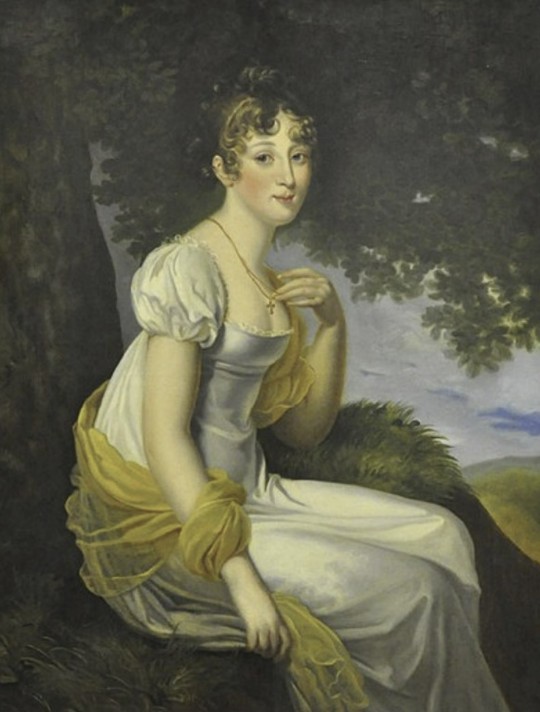
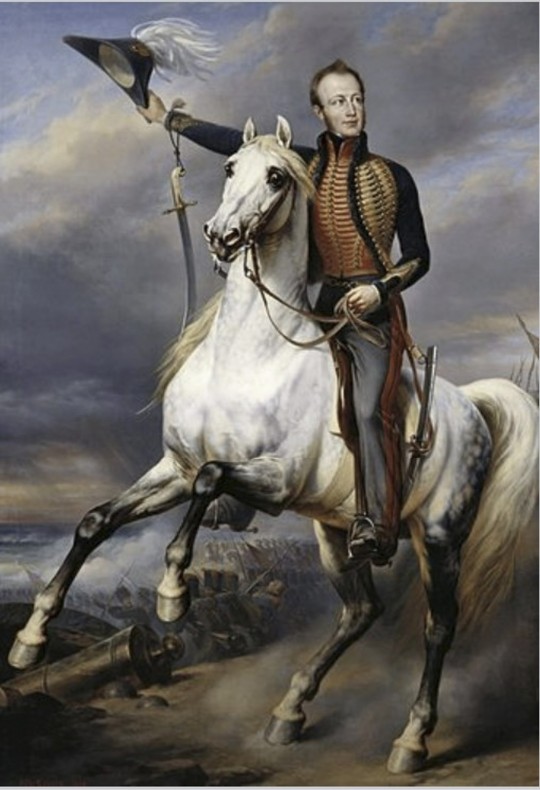
Anna was an excellent dynastic match as well as beautiful and intelligent. After considering several illustrious matrimonial prospects (the prospective Bourbon heir, the Duc de Berry, and the British Duke of Clarence), her brother Tsar Alexander I arranged her marriage to William of Orange, who would later become King William II of the Netherlands (making Anna his Queen.) She married William at the Winter Palace in Saint Petersburg. Her dowry was one million rubles.
The couple remained in Russia for one year before leaving for the Netherlands (her governess accompanied her.) Anna had problems adjusting at first, and although she came to enjoy her life in Brussels, where the nobility liked her, she always considered herself, first and foremost, a Russian Grand Duchess. She always believed she had married beneath her station. Hot-tempered and seen as elitist, Anna lamented that she could not have remained in Russia, which she visited frequently.

Her only political role as the crown princess was mediating between her husband and his father. She considered her role as a royal woman to be predominantly in charity and was very involved and successful. She founded a charity commission and a school in needlework for poor women and girls and gave financial contributions to the Anna Paulowna and Sophia schools. After the death of her mother-in-law in 1837, she took over the protection of the charity “mother foundations.” She founded a hospital in The Hague for wounded soldiers, whom she visited regularly.

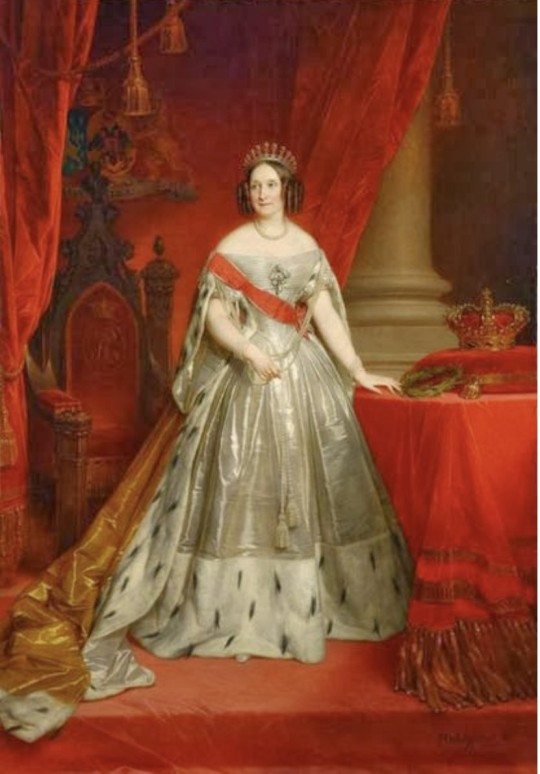
As Queen, she would never be popular and remained distant from the public; however, because she greatly valued court etiquette and ceremony, the Dutch court reportedly acquired more “royal allure” during her tenure.

Anna’s marriage was stormy; her husband was unfaithful. However, she always supported him in public. They had five children: William (on whom she focused her attention as the heir and who she unsuccessfully tried to dominate), Frederick Henry, Alexander (her favorite), and Sophia (who would eventually be the Grand Duchess of Weimar-Eisenach). She was a devoted mother. Anna eventually separated from her husband. Despite this, she continued to advise him and acted as his Queen Consort.
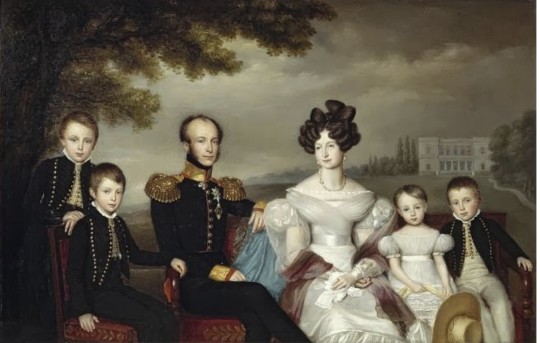


Anna Pavlovna died from a respiratory ailment. On the death of her husband in 1849, Anna was bereft and found it hard to come to terms with the loss of her official standing. She suffered financial difficulties as queen dowager and lived in quiet seclusion, constantly clashing with King William III and her daughter-in-law.


Post link
Grand Duchess Xenia Alexandrovna Romanova (1875 - 1960) - Part 2 of 3
Grand Duchess Xenia Alexandrovna and Grand Duke Alexander Mikhailovich got married in 1894. Unfortunately, her wedding was the last public event Tsar Alexander III attended. They married in August and the Tsar died in November. Xenia’s brother Nicky ascended to the throne of Russia as Nicholas II and married Princess Alix of Hesse, who became Empress Alexandra Feodorovna.
The two couples developed a very close relationship. Sandro held important posts during Nicholas II’s reign but he does not seem to have acquired the influence he should have as the Tsar’s brother-in-law, a relationship that placed him in extremely close proximity to the seat of power. The relationship between Nicholas and Alexandra and Sandro and Xenia was, indeed, a close one during the first few years of their marriage, yet it eroded slowly. The reasons for this are multiple and varied. Xenia and Sandro’s lifestyle was not as “sheltered” as Nicholas and Alexandra’s. Also, as the Empress gave birth to four beautiful girls in succession, Xenia’s first born daughter Irina was followed by six consecutive healthy sons. This could not have been a comfortable state of affairs for Alexandra who was eager to produce just one boy and seemingly could not. Although this was probably not the determinant factor in the cooling of her relationship with her sister in law, it must have contributed to it. What doomed the relationship was the fact that as the young Empress gained influence over Nicholas, his mother, the dowager, lost hers; Xenia sided with her mother. And let us not forget the gradual involvement of the imperial couple in matters related to mysticism (first in the guise of Monsieur Phillipe, and much later through the person of Rasputin) an interest not at all shared by Xenia and Sandro at that point.
Xenia and Sandro’s marriage seems to have been a love match. Given Grand Duke Alexander’s restless personality, it is no surprise that he would eventually find other love interests. The grand-ducal couple spent long periods of time outside of Russia, making the rounds of Biarritz, Cannes, etc with their ever expanding brood in tow. During Xenia’s pregnancy with her last child, Grand Duke Alexander fell in love with a Spanish/Italian woman we only know as Maria Ivanova, who was a frequent guest at the parties Xenia and Sandro gave. He decided to come clean to Xenia, and they opted to live “together but apart” for the sake of the children. They never got a divorce although Sandro asked Xenia for one several times through the years. The affair with Maria Ivanova lasted a number of years. Afterwards, there were other women in Sandro’s life; Xenia also took a lover (whose identity is not known for sure; there is speculation that this lover was an Englishman we know only as “Fane;” while others mention Prince Sergei Dolgoruky, an adjutant to the Dowager Empress - it is possible that these are two individuals Xenia had relationships with at different points in time.) Although both Sandro and Xenia were extremelly discreet, the state of their marriage was more or less an open secret. Empress Alexandra Feodorovna greatly pitied “poor litte Xenia with that terrible husband.”
Xenia and her mother remained very close. The Dowager Empress came to depend on Sandro and grew particularly close to Xenia’s children, especially beautiful, ethereal Irina. She derived all the enjoyment from these grandchildren that she could not from her son Nicholas’ offspring, since her contact with them was limited.
When World War I erupted, Xenia, Sandro, Maria Feodorovna, Irina, who by now was married to the eccentric Prince Felix Yusupov (one of the richest men in Russia) were all out of Russia. They hurried back home to serve their country for what they did not know would be one last time.
Photographs: 1. Illustration of different “scenes” from Grand Duchess Xenia Alexandrovna’s wedding to Grand Duke Alexander Mikhailovich (this was the last public event that Alexander III was able to attend due to his final illness.) 2. A very young Xenia (she must have been between 18 and 19 years old) holding her first born child and only daughter Irina); 3. Grand Duchess Xenia wearing a beautiful and very becoming boyarina costume; 4. Formal portrait of Grand Duchess Xenia Alexandrovna; 5. Grand Duchess Xenia Alexandrovna at sea 6. Xenia and Sandro with their seven children, Irina, Andrei, Feodor, Nikita, Dmitry, Rostilav and Vasily; 7. Grand Duchess Xenia and her children; 8. Xenia, her daughter Irina and her granddaughter Bebe; 9. Xenia and Sandro with friends; 10. Xenia, a very dapper Sandro and entourage in Biarritz
Post link
Victorian Men’s Hairstyles & Facial Hair
A collection of Victorian photographs, depicting some of the hairstyles and facial hair fashion of the time, and a few rather unique hair styles like a man with ringlets.
Woman’s Hairstyles
Victorian [x] | Edwardian [x] | 1920’s [x] | 1930’s [x] | WW2 [x]
Post link
My Grandpa Ehemann was by all accounts a car guy. Before his scrapbook came into my hands I had found a stack of receipts for cars he had purchased. At some point I should take them and I see if I can tell which was which from his photos. (That ‘49 Hudson on the first page top right is pretty fantastic looking!)
The majority of the photos were taken in front of their place on the corner of N. Paulina & W. Ainslie Streets on the north side of Chicago. The bottom photo on the second page was shot in front of the house I grew up in on Kostner Ave. That old Standard Oil gas station has since been replaced by a North Shore Community Bank & Trust building.
Post link




